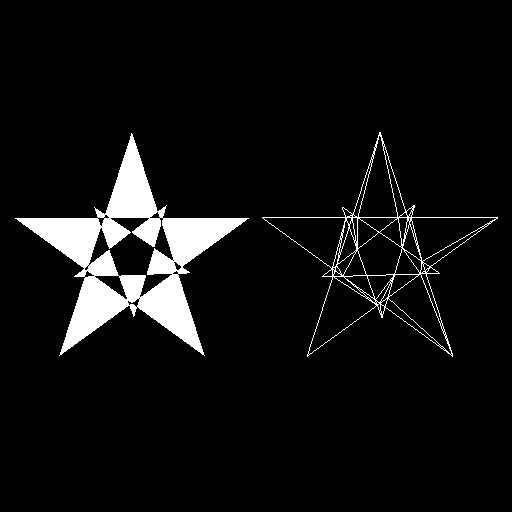In this tutorial you will learn how to use the vl::Tessellator class to tessellate a concave or self intersecting polygon into a set of triangles that can be rendered with Visualization Library.

[From App_Tessellator.cpp]
class App_Tessellator: public BaseDemo
{
public:
App_Tessellator() {}
void initEvent()
{
// Basic initialization
vl::Log::notify(appletInfo());
// Filled effect
// Wireframe effect
// Add empty Actors
mStar1 = sceneManager()->tree()->addActor( new vl::Actor(NULL, filled_fx.get(), new vl::Transform) );
mStar2 = sceneManager()->tree()->addActor( new vl::Actor(NULL, wireframe_fx.get(), new vl::Transform) );
rendering()->as<vl::Rendering>()->transform()->addChild(mStar1->transform());
rendering()->as<vl::Rendering>()->transform()->addChild(mStar2->transform());
}
void updateScene()
{
// Animation: compute rotation matrix to rotate the small star, 45°/sec rotation.
// Filled star on the left, wireframe star on the right
mStar1->transform()->setLocalMatrix( vl::mat4::getTranslation(-4,0,0) );
mStar2->transform()->setLocalMatrix( vl::mat4::getTranslation(+4,0,0) );
// Concave and self-intersecting polygons cannot be directly rendered by OpenGL, for this
// reason in order to render them we have to tessellate them first, i.e. we have to decompose
// them into a set of triangles using the Tessellator class.
// The Tessellator class takes as input a set of contours defining a complex polygon and
// outputs a series of triangles that can be rendered by OpenGL and Visualization Library
vl::Tessellator tess;
// Setup tessellation options, see also gluTessProperty() documentation.
tess.setTolerance(0.0); // default
// Outline #1 - generate 5-points star (small)
int size = 2;
tess.contours().push_back(5);
for(int i=0; i<5; ++i)
{
// Fill the first contour
}
// Outline #2 - generate 5-points star (big)
size = 4;
tess.contours().push_back(5);
for(int i=0; i<5; ++i)
{
// Fill the second contour
}
// Tessellate the two contours into a single polygon
tess.tessellate();
/*
You can also tessellate each contour separately selecting setTessellateIntoSinglePolygon(false).
This way each contour will be processed separately and will generate its own set of triangles, this
is useful when you want to tessellate a large number of polygons with a single tessellate() call.
*/
// Create a new Geometry and vertex array with the tessellated triangles
tess_poly->setVertexArray(vert_array.get());
// Fill the vertex array with the tessellated triangles
vert_array->initFrom(tess.tessellatedTris());
// Add the primitive description
tess_poly->drawCalls().push_back( new vl::DrawArrays(vl::PT_TRIANGLES, 0, (int)vert_array->size()) );
// Bind the created Geometry to the star Actor
mStar1->setLod(0, tess_poly.get());
mStar2->setLod(0, tess_poly.get());
}
protected:
// the Actor defining our complex star
vl::Actor* mStar1;
vl::Actor* mStar2;
};
// Have fun!